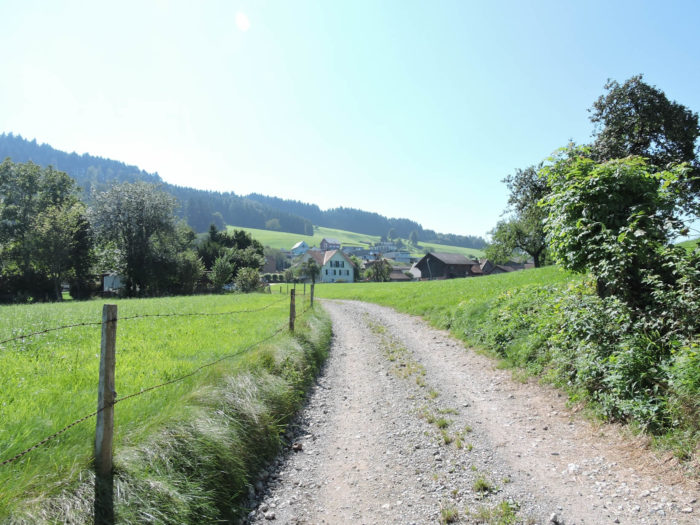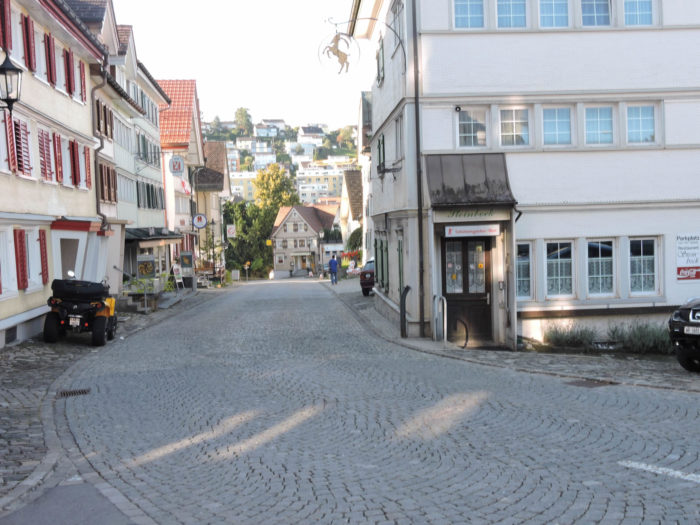Towards St Gallen, in the UNESCO heritage
DIDIER HEUMANN, ANDREAS PAPASAVVAS

We divided the course into several sections to make it easier to see. For each section, the maps show the course, the slopes found on the course, and the state of the route (paved or dirt roads). The courses were drawn on the « Wikilocs » platform. Today, it is no longer necessary to walk around with detailed maps in your pocket or bag. If you have a mobile phone or tablet, you can easily follow routes live.
For this stage, here is the link:
https://fr.wikiloc.com/itineraires-randonnee/de-rohrschach-a-herisau-par-la-via-jacobi-4-31728164
|
Not all pilgrims are necessarily comfortable using GPS or navigating routes on a mobile device, and there are still many areas without an internet connection. For this reason, you can find several books on Amazon dedicated to the major Via Jacobi 4 route, which runs through the heart of Switzerland and over the Brünig Pass. The first guide leads pilgrims through the German-speaking part of Switzerland up to Fribourg, while the second continues through French-speaking Switzerland to Geneva. We have also combined these two books into a compact, lighter, and highly practical version. While the descriptions have been slightly condensed, they remain detailed enough to guide you step by step along the way. Recognizing the importance of traveling light, this latest edition has been designed to provide only the essentials: clear and useful information, stage by stage, kilometer by kilometer. The stages have been carefully adjusted to ensure accessibility and alignment with available lodging options. These books go beyond simple practical advice. They guide you kilometer by kilometer, covering all the crucial aspects for seamless planning, ensuring that no unexpected surprises disrupt your journey. But these books are more than just practical guides. They offer a complete immersion into the enchanting atmosphere of the Camino. Prepare to experience the Camino de Santiago as a once-in-a-lifetime journey. Put on a good pair of walking shoes, and the path awaits you.
|

|
 |
If you only want to consult lodging of the stage, go directly to the bottom of the page.
The main route of the Via Jacobi 4, the Way of St. James in Switzerland, starts from Constance, on the shores of Lake Constance, the Bodensee. However, you can also start from Rohrschach, a little further down the lake. Many pilgrims coming from Germany, Austria, or Eastern countries arrive in Lindau, Germany, or Bregenz, Austria. They take the boat to reach Rohrschach. The advantage of choosing the route via Rohrschach over the Constance route is that it passes through St. Gallen. However, both routes converge in Rapperswil, on the shores of Lake Zurich, at the end of the canton of St. Gallen. In the early stages in Switzerland, the Via Jacobi crosses the canton of St. Gallen from end to end, with a brief transition in the canton of Appenzell, enclosed within the canton of St. Gallen.
Today’s stage passes through the magnificent city center of St. Gallen and its collegiate church, listed as a UNESCO World Heritage Site. Another legendary point to note, before arriving in St. Gallen, the route crosses the St. Martin’s Bridge (Martinsbrücke) over the deep and wild gorges of the Goldbach. Another rugged area is the Sitter gorges, with its impressive viaducts at the exit of Bruggen.

Difficulty level: The journey alternates between urban and rural areas, with relatively steep but manageable gradients (+783 meters/-426 meters). Of course, the Way of St. James in Switzerland avoids high mountains and Alpine passes. However, being in Switzerland, a country of mountains and high hills, there are few stages in the plains. The first part of the route is almost constantly uphill until reaching the heights of St. Gallen. The most difficult portion is near the Goldbach river, before St. Gallen, with gradients sometimes exceeding 25%. After that, the route is relatively easy.
State of the Via Jacobi: In this stage, the stretches on tarmac exceed those on paths:
- Paved roads: 14.3 km
- Dirt roads : 11.3 km
Sometimes, for reasons of logistics or housing possibilities, these stages mix routes operated on different days, having passed several times on these routes. From then on, the skies, the rain, or the seasons can vary. But, generally this is not the case, and in fact this does not change the description of the course.
It is very difficult to specify with certainty the incline of the slopes, whatever the system you use.
For those seeking « true elevations » and enthusiasts of genuine altimetric challenges, carefully review the information on mileage at the beginning of the guide.

Section 1: From Bodensee to the hills

Overview of the route’s challenges: uphill climb towards Sulzberg Castle; the remainder of the route is somewhat less demanding, even though there’s an ascent of nearly 200 meters over 4 kilometers.

|
Amidst the gentle whispers of Lake Constance’s waters, whether arriving here by boat or train, you must make way to the harbor.
|
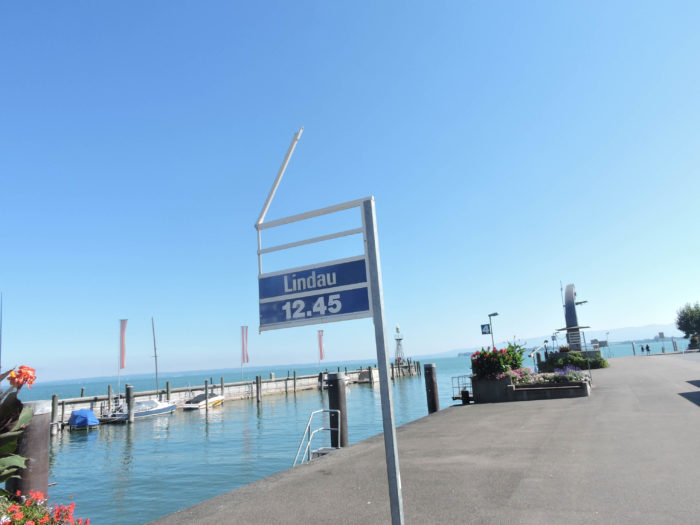 |
 |
| Choosing the right route, the Via Jacobi 4, is a quest of selection among a myriad of winding paths that weave through these gentle and peaceful lands. |
 |
 |
The Via Jacobi follows Signalstrasse up to the church and the railway line. The canton of St Gallen is predominantly Catholic, with only a quarter of the population identifying as Protestant. Further ahead, in Herisau, in Appenzell Ausserrhoden, Protestantism dominates Catholicism.
|
 |
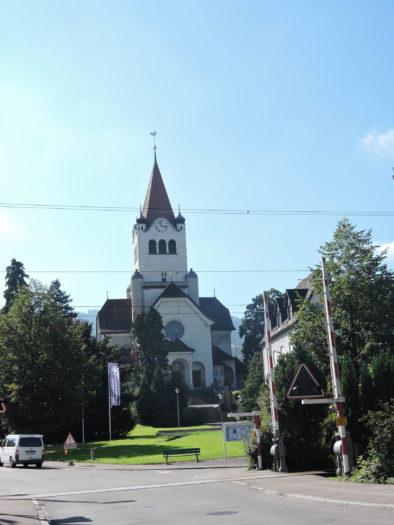 |
| Here, the Via Jacobi 4 isn’t well signposted, but you won’t get lost. You can take Löwenstrasse to the right until you find Rue de l’Industrie. |
 |
 |
| Then, slope up this latter street to cross the railway track towards the upper town, passing near the Permapack factory. |
 |
 |
| At the end of Rue de l’Industrie lies the Enjoy hotel, from where Appenzellerstrasse begins. It’s also here that you’ll find indications for Via Jacobi. |
 |
 |
| Beyond the twists of Appenzellerstrasse, where modern villas stand proudly like sentinel guardians of history, the road slopes up, challenging the horizon towards the distant highway. |
 |
 |
| At the summit of this ascent, where asphalt gives way to nurturing earth, a discreet path unveils itself, inviting you to traverse a scattered wood, where the murmurs of the town silence to make way for the symphony of nature. |
 |
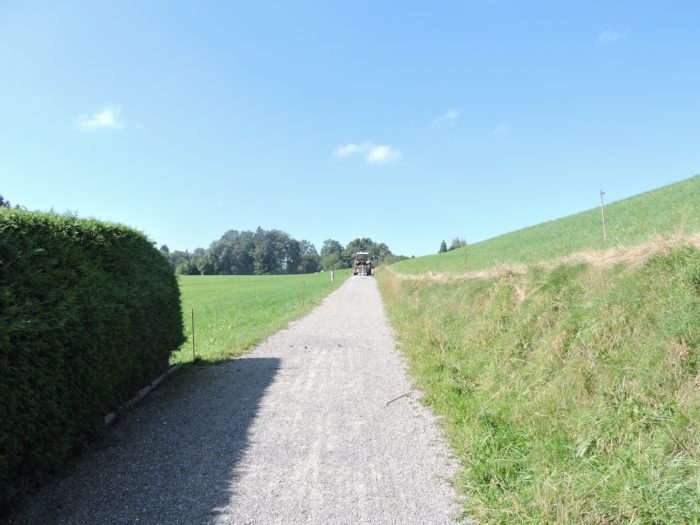 |
| Now, streets bear again names, Hohrainstrasse, Egertenstrasse, like yellowed pages of an old book, before leading you to the soothing murmur of Dorfbach stream. |
 |
 |
| Following the traces of old Egertenstrasse, you head towards the highway, skimming past Goldach, the vast suburb of Rorschach, stretching majestically from the mountains to the lake. Here, nature reveals itself as gentle and welcoming, offering a soothing contrast to the urban tumult. A large shaded park extends beneath towering trees, where centuries-old trunks form a cathedral of greenery. |
 |
 |
| The Via Jacobi then crosses the highway over a speed bump. Here, the vines embrace the hills, revealing the wine-growing delights of this elevated suburb. |
 |
 |
Alas, the radiant beauty of this vine-clad estate sadly coexists with the dull roar of the nearby highway.

| Beyond the steel ribbon of the highway, a rocky path proudly climbs, leading you towards Sulzberg Castle, where echoes of the past blend with murmurs of Lake Constance (Bodensee). |
 |
 |
| It was the Bishop of Constance who, at the beginning of the 13th century, had Sulzberg Castle erected here. Only the keep remains of the original structure. The castle then changed owners several times over the centuries. It’s now in private hands. |
 |
 |
From the esplanade, where the wind caresses dreams, Lake Constance unfolds in all its splendor, offering a breathtaking spectacle amidst the fertile furrows of the vegetable garden.

| A word of caution is necessary here, like a whisper of wisdom in the heart of the woods. A sign indicating the Way of St James, marked with the scallop shell, can be found here. However, on the Via Jacobi, the shell never points the way, as it does in France. So, guide your steps with confidence, and resist the temptation of the path on the right, favoring instead the gentle murmur of the path that winds through the calm waters of the small Schlossweiher Lake. Nestled in a forested haven, far from beaten tracks and curious gazes, the wild lake is enveloped in sacred silence. Its waters are dark and mysterious, tinged with a murky hue that betrays the passage of time and the richness of the life hidden within. Broad-leafed water lilies float lazily on the surface. The trees encircling the lake form a dense canopy. Here, the stagnant waters, the dreamy water lilies, and the swaying tall grasses blend into perfect harmony, offering a vision of raw and untamed natural beauty. |
 |
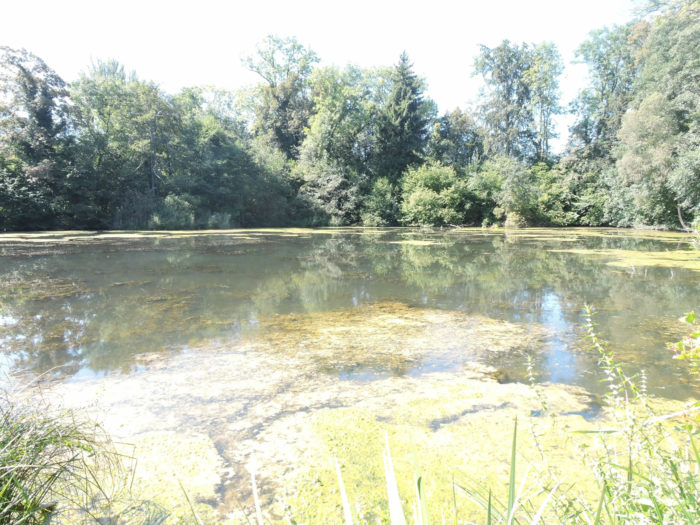 |
| Shortly after, as you follow the enchanting song of the Bettlerenbach stream, the landscape opens before you—a symphony of lush meadows and enchanted orchards, where rain, the faithful companion of these fertile lands, nourishes nature’s soul. For pilgrims unfamiliar with Switzerland, the ever-present greenery of the meadows will be a constant wonder. It must also be said that rain is quite frequent here. |
 |
 |
Section 2: Traveling through the quaint villages of Untereggen up to the summit of the hill

Overview of the route’s challenges: a steady ascent, with small stretches exceeding 15%; steep descent towards the Goldbach gorge, potentially arduous in bad weather.

|
Traversing the Swiss countryside is embarking on a picturesque symphony of verdant landscapes where the charms of nature intertwine with the history of the places, akin to chapters of a living book. Along a winding dirt road, the traveler delves into a bucolic tableau, where meadows stretch as far as the eye can see, punctuated here and there by modest farms and scattered groves, offering a haven of peace far from urban hustle.
|
 |
 |
|
Midway up, the path reveals the charming spot of Vogelherd, while the road winds towards Untereggen. Here, prosperity hints in the details, like these meticulously painted postal bus stops, witnesses of a thriving community.
|
 |
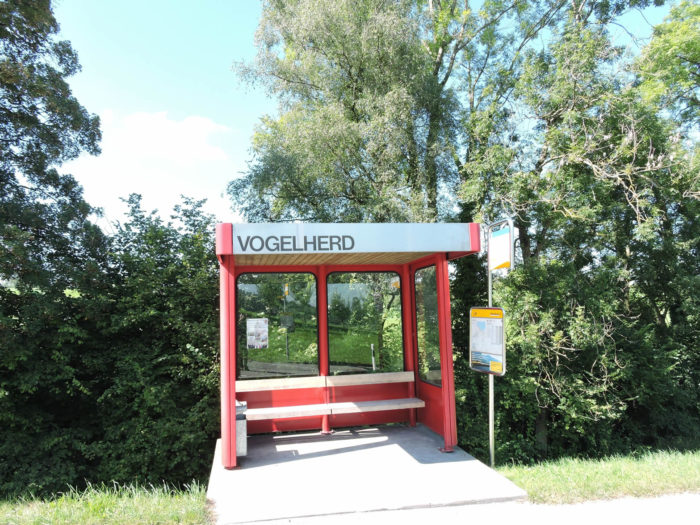 |
| The Via Jacobi, faithful companion of pilgrims, slopes up majestically, scaling the ridges and crossing the Hochstaudenbach river, while a modest oratory proudly stands by the roadside, evoking the piety of traveling souls. |
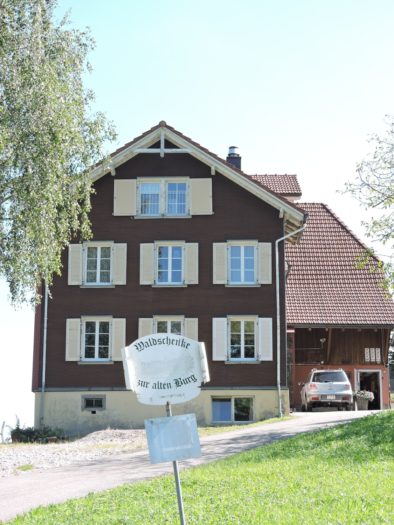 |
 |
| Then, gracefully as a nimble steed, the road elegantly forks towards the hamlet of Brand. |
 |
 |
| Here, traditional wooden houses harmoniously mingle with those adorned with shingles, revealing the authenticity of a preserved heritage. Tavillons or shingles are a Swiss term for wooden tiles. |
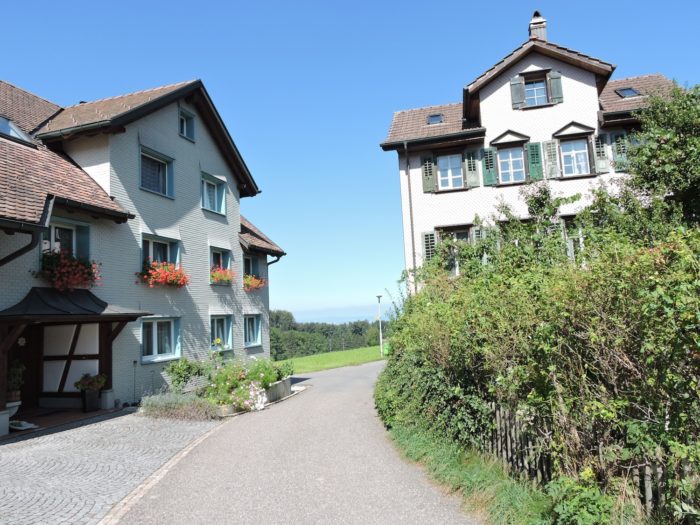 |
 |
| At the heart of this rural setting, a path, half earthen, half grassy, dives under the cover of a dense forest, following the rushing waters of a Hochstaudenbach tributary, while nature unveils its splendor with every step. |
 |
 |
| Higher up, the path merges into the fabric of the main road, joining the village of Vorderhof, the epicenter of rural life in Untereggen, where the Santa Madalena church stands as a guardian of time, bearing witness to centuries of history and faith. |
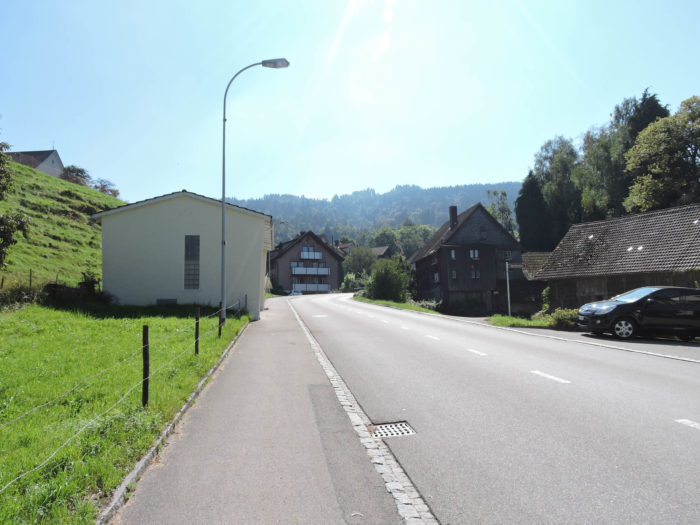 |
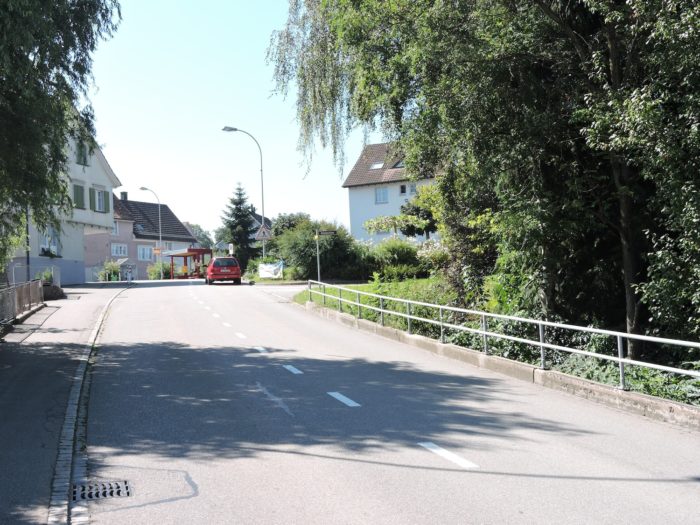 |
| The dwellings, true architectural jewels, evoke the craftsmanship and aesthetic taste characteristic of German-speaking Switzerland, while an inn invites travelers to a comforting stopover, in an atmosphere of conviviality and warmth. |
 |
 |
| At the turn of Zielgasse, the Via Jacobi veers off the main road, venturing onto a small paved road… |
 |
 |
| …which gradually transforms into a wide path of dirt and grass, winding through pastures and farms up to Mittlerhof. |
 |
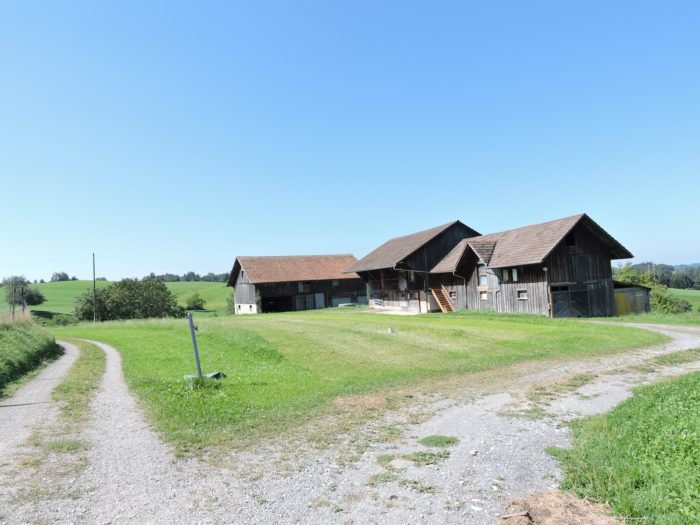 |
| In Mittlerhof, the Via Jacobi returns to the ordinary, following the course of the main road that winds through the villages of Untereggen, silent witnesses to a millennial history. |
 |
 |
| Vorderhof, Mittlerhof, and the charming Hinterhof blend into the landscape, united by a shared destiny and the gentle chime of church bells. Here, each village, however modest, has its own bus stop, symbolizing unparalleled accessibility. Compared to the scarcity of transport options on the routes of the French Camino de Santiago, the omnipresence of transport possibilities in Switzerland is striking and thought-provoking. |
 |
 |
| Further on, the Via Jacobi continues its journey, following the twists and turns of the main road to the village of Hinterhof. |
 |
 |
| In the village, it takes flight on a secondary road, gracefully slopping up towards the heights of Schiben. |
 |
 |
| Theribbon of asphalt boldly meanders through the pastures, offering walkers a breathtaking spectacle, punctuated by the dance of sheep and the whisper of the wind. |
 |
 |
| At the top of the hill, the hamlet of Schiben unveils itself, like an oasis of tranquility, where houses nestle against each other, as if to better protect themselves from the whims of weather. |
 |
 |
| Emerging at the place called Steingruben, you have steadfastly climbed an ascent of 400 to 670 meters in altitude over a course of 8 kilometers, marked by gentle slopes, save for a few exceptions. Here, nature becomes wilder, unfolding before your astonished eyes a vertiginous descent, sometimes challenging for your joints. |
 |
 |
| The descent looms ahead, first on a rough trail winding through the foliage of the woods, then in the open in the meadows. Some passages, inclined at over 25%, will demand special attention from your knees and ankles. With relief, you will happily find the road at the bottom of this descent. |
 |
 |
Section 3: A serious climb before descending to St Gallen

Overview of the route’s challenges: steep climb up to Schaugenhof; then a steady descent towards St Gallen.

|
The winding meanders of Goldbach murmur their millennial song, traversing ages with immutable majesty. The vertiginous gorges stand as sentinels, contemplating the fleeting passage of time. Once, the St. Martin Bridge (Martinsbrücke), a centuries-old structure suspended above tumultuous waters, connected both shores with a stone link, perpetuating the legacy of bygone generations. Now replaced by a more modern structure, it remains the indelible imprint of a glorious past.
|
 |
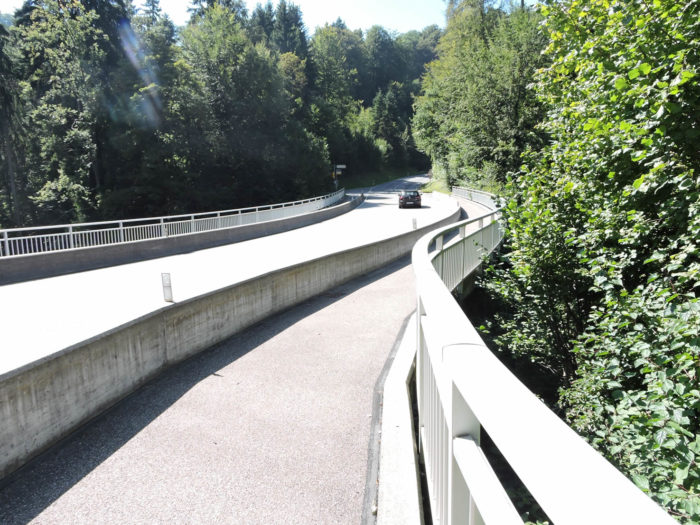 |
| Following an enchanting route, the Via Jacobi escapes toward Schaugenbädli, gently accompanying the soothing murmur of the watercourse. Here, passion is expressed not only in game hunting but also in the distant echoes of shooting ranges, hidden deep within dense forests. |
 |
 |
The ascent, enough demanding and punctuated by moments of contemplation, unfolds between dirt paths and paved roads, offering an enchanting ballet through verdant meadows. The atmosphere is tinged with a gentle pastoral melody, evoking high Alpine pastures, despite the proximity to the city of St Gallen.
|
 |
 |
| Midway, the Schaugenbädli refreshment stand, a welcome haven of peace, invites thirsty travelers to catch their breath, while German becomes the precious key to harmoniously blend into the local ambiance, where French or English are rare. |
 |
 |
| From the refreshment stand, as the altitude becomes palpable, lush meadows give way to dirt paths, challenging pilgrims’ steps with a fervent ascent. |
 |
 |
| Then, a grassy trail sharply climbs along the undergrowth amidst cows. Here, the slope is steep, exceeding 20%. The Braunvieh (brown cow), found in German-speaking countries, originates from Switzerland. It sports a brown coat ranging from wheat-gray to dark chestnut, with the bull being darker. The muzzle is slate-gray surrounded by a white halo. The ears are adorned with long white hairs reminiscent of plush. This breed, in German-speaking Switzerland, represents 47% of the bovine population, just behind the Simmental. This dual-purpose breed is known for its hardiness, suitable for mountain conditions, as it thrives on sparse forage. |
 |
 |
Below, your gaze extends over the valley carved by the Goldach that you have partly visited.

| In this woodland where oaks, beeches, and spruces intertwine, birdwatching is probably not cherished; rather, it’s the hunting of wood pigeons, akin to the Southwest of France, |
 |
 |
| Above, the path then runs near very beautiful farms, all magnificent in the region. What an extraordinary taste for beautiful dwellings among the peasants of yesteryears! In the 19th century, nail production mechanized, leading to a drop in prices. Consequently, in central and eastern Switzerland, many buildings were covered with shingles. How many homes, rich or poor, have been adorned with these tiled coats, sometimes with over 100,000 units, an ideal protection in these harsh and humid climates? |
 |
 |
| Higher still, the path winds its way between cows and sheep amidst rare opulence, where even the meadows are paved to accommodate the most modern tractors. |
 |
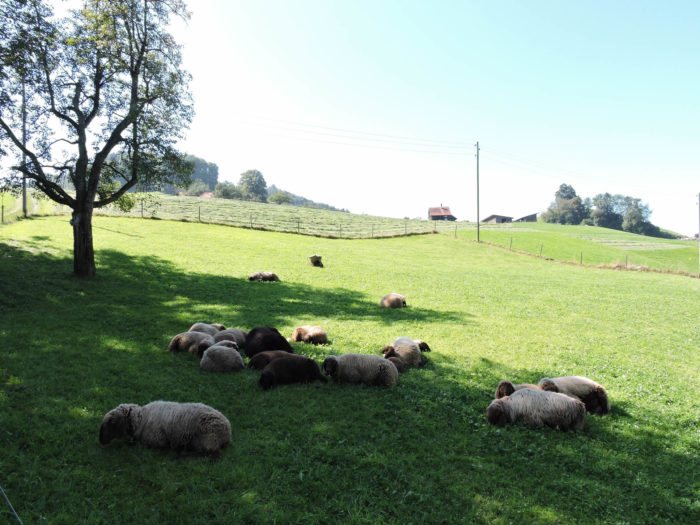 |
| It soon reaches Schaugenhof on the road, above St Gallen. Restaurants and refreshment stands abound along the way. Here, you depart from the countryside to approach the city. |
 |
 |
| Beyond Schaugenhof, the Via Jacobi descends slightly onto the road before cutting onto a dirt path, the Schachenbüelweg, in the suburbs of St Gallen composed of modern buildings and farms. Farms, not far from the city center, what country still affords such luxury? Switzerland, of course. German-speaking Swiss farmers are so proud of their heritage that developers often find closed doors. How long will this last? |
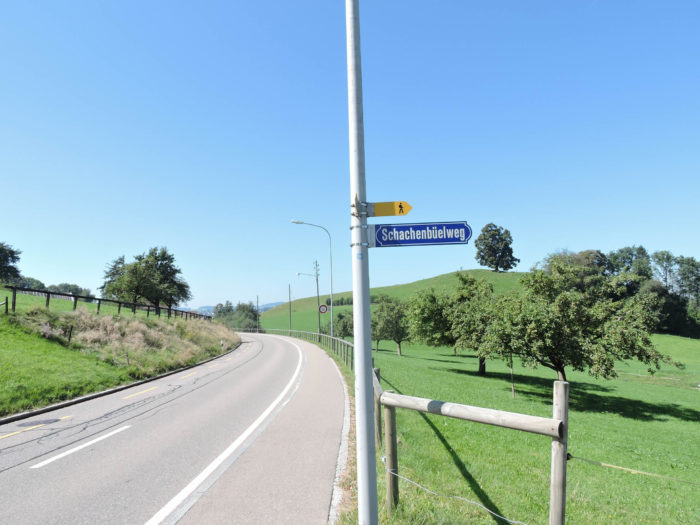 |
 |
| A stone’s throw from the city, there are still farms and brown cows in the meadows. |
 |
 |
| At the bottom of the descent, you are at the city’s entrance. Crossing St Gallen will probably seem endless (about ten kilometers to Bruggen). But the city center is remarkable. The Via Jacobi first ascends Reherstrasse, where old residences can still be found. |
 |
 |
| Shortly after, the Via Jacobi then closely follows Martinsbruggstrasse. |
 |
 |
Here, the municipality has nothing against folk art.

| At Blumenwiess, the Via Jacobi takes Fuchsenstrasse, which runs out of the city center axis. Nevertheless, the idea is not to lead the pilgrim onto the city’s busy roads. |
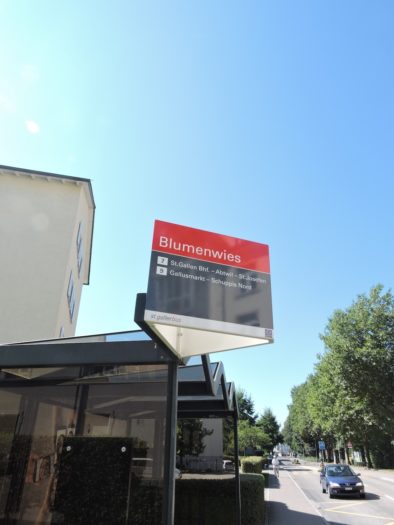 |
 |
| Further on, Fuchsenstrasse continues as Iltistrasse, at the edge of the forest. |
 |
 |
Section 4: Passing through St Gallen, a Swiss gem
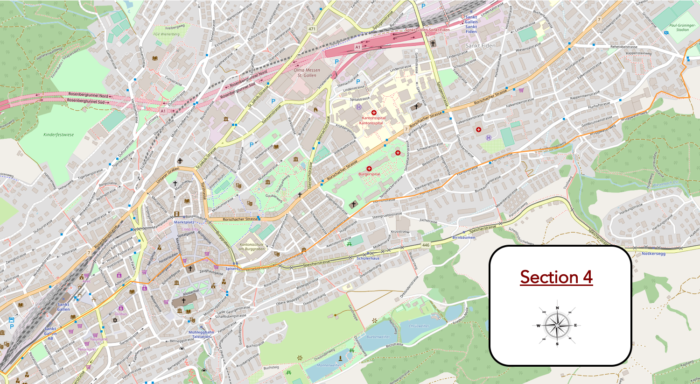
Overview of the route’s challenges: The route is without difficulty.
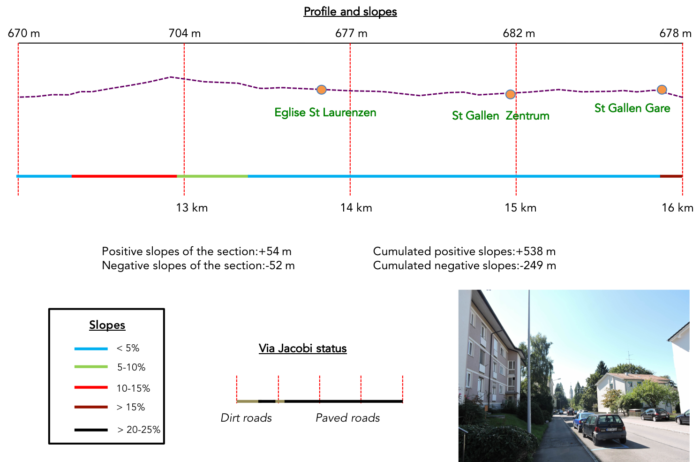
|
In the gentle flow of your thoughts, you will traverse the streets and alleys of a once slumbering city, wrapped in the discreet charm of its peripheral neighborhoods, far from the bustle of the main city arteries. Before getting lost in the labyrinth of the city center, your steps will lead you through a succession of old suburbs, where ancestral buildings stand alongside centuries-old trees draping the surrounding hills. At the end of Iltistrasse, Grütliweg takes over. It’s a narrow path weaving between buildings, some still retaining the charm of yesteryears.
|
 |
 |
Like a pilgrim in search of serenity, the route gradually ascends along Bruggwiesenweg, as if to escape urban constraints. Crossing St. Gallen proves to be a true challenge, first as a frenzied dance through the quiet streets of the city.

| The route, alternately caressed by the shadow of woods, finally nestles back among the residences, sometimes revealing the surprising juxtaposition of elegant ancient mansions and more modern constructions. It is easy to imagine that these neighborhoods were once on the outskirts, gradually encroached upon by the sprawling expansion of the city, regardless of their singular character. |
 |
 |
What can be said of such a jewel lost in nature?

| Turning onto Golbrunnenweg, the route persists in this architectural symphony, where the past and present harmoniously blend between new residences and ancient remnants. |
 |
 |
| Further along, the path delightfully follows the murmur of a modest stream, approaching the outskirts of the city. What a strange sensation to still tread, in the heart of the urban area, the wooded paths of yesteryears. |
 |
 |
| So far, the Via Jacobi has preferred to bypass the main arteries, preferring to meander among the peripheral neighborhoods, on the edge of the forest. But St Gallen holds so many treasures to discover that the route must include them. At the intersection of Golbrunnenweg and Furhofstrasse, a peaceful street still far from urban tumult, stands the majestic St Laurenzen Church. |
 |
 |
| St Laurenzen Church is the Reformed Evangelical Church of St Gallen, the second most important in the city after the cathedral. It is protected as a historical monument and of national importance. The current church dates back to the 15th century but was rebuilt in neo-Gothic style between 1850 and 1854, then recently restored. |
 |
 |
It is rumored that from its bell tower, one can embrace the splendor of the old city. But to fully enjoy it, one must adhere to the schedules of guided tours, organized twice a day

| Next, you will need to follow Linsebühlstrasse to reach the historic heart of the city. |
 |
 |
| And thus, gradually, Via Jacobi emerges into the historic center of St Gallen, offering visitors the opportunity to delve into the intricacies of a millennium-old history. |
 |
 |
| The history of St Gallen Abbey is a very long one. The monastery was founded in 613 in honor of Gallus, who died here at that time. Charles Martel appointed a certain Othmar as guardian of the relics of Saint Gall. It was during the reign of Pepin the Short that Othmar founded the famous schools of St Gallen where arts, letters, and sciences flourished. A little later, the copying of ancient manuscripts began, giving rise to the famous St Gallen Library. Over 400 manuscripts, including the earliest Gregorian chants, survive from this time, despite the vicissitudes of time and the constant relocation of precious books. |
 |
 |
At the entrance to the library, a true sanctuary of knowledge, the distant evocation of Compostela mingles with the scents of parchment and ancient ink.

| In the 13th century, the abbey and the city were governed by abbots of the Holy Roman Empire. But alas! Few vestiges of the medieval abbey remain. Only the books endure. The Benedictine abbey was dissolved in 1805, and the cathedral rebuilt between 1755 and 1770 in Baroque style. Nevertheless, the site of St Gallen Monastery is inscribed on UNESCO’s World Cultural Heritage list. And it truly deserves it. It’s just a great wonder. |
 |
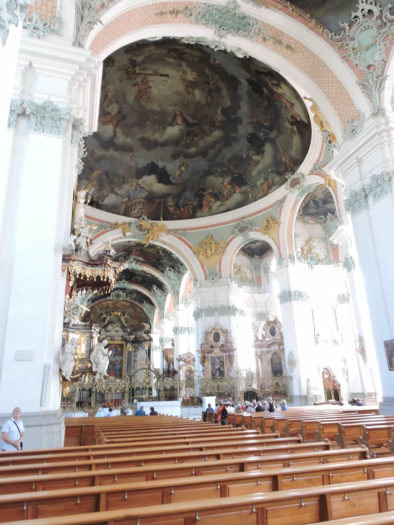 |
| The square in front of the abbey, a vibrant tableau of architecture, exhales an enchanting charm, a testimony to a glorious past. |
 |
 |
| St Gallen, with its more than 75,000 inhabitants, gradually reveals itself as Via Jacobi emerges from the center, winding through the shopping area on Schmiedgasse, along the stalls of the Globus store, taking Vadainstrasse and then Kornhaustrasse before heading onto the grand St Leonard-Strasse. |
 |
 |
| Further along, it follows this same artery to the train station. |
 |
 |
Section 5: From St Gallen to Bruggen, passing through the suburbs

Overview of the route’s challenges: The route presents no significant difficulties.

|
However, your journey through the city is far from over. After leaving the confines of the train station, St Leonard-Strasse gracefully crosses the railway tracks, showcasing the elegance of St Leonard’s Church. This architectural gem, once a stronghold of the evangelical reformed faith, erected in 1887, was relinquished over the years, in 2004, under the weight of neglect and unsustainable expenses. Its new owner, driven by bold cultural ambitions, envisions its transformation into a center for artistic awakening, although the project remains in abeyance, frozen in anticipation of better days.
|
 |
 |
| Subsequently, the Via Jacobi meanders, like a winding river, alongside the railway tracks… |
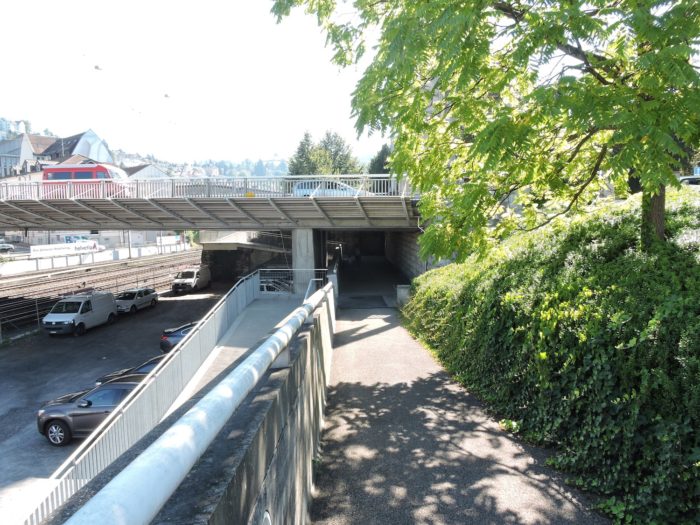 |
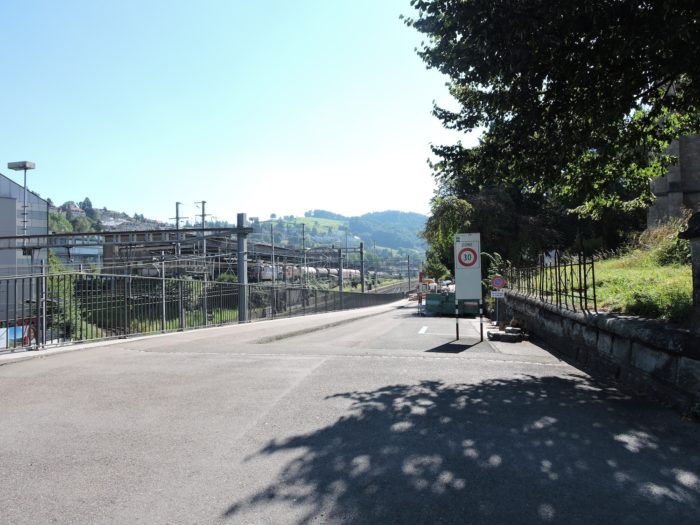 |
… before running along Burgstrasse.
|
 |
 |
| A few furlongs ahead, it forsakes the latter for the mundane invitation of Wonwilstrasse, then Schillerstrasse, before finding its initial course again on Burgstrasse. You also have the option to follow the latter throughout its course. The journey is punctuated by the presence of modest religious buildings, perhaps witnesses of another fervent faith. |
 |
 |
| At the end of Burgstrasse, Via Jacobi embarks on the more enchanting path of Burgweiherweg, thus marking the symbolic boundary with St Gallen. |
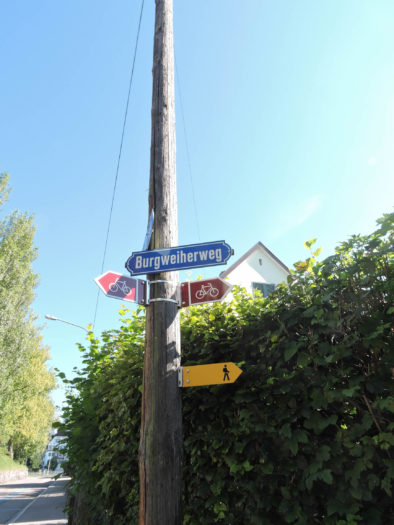 |
 |
| After leagues of oppressive concrete, what a delight to encounter the dirt road and the gentle Simmental cows! Originating from across the Rhine, these charming creatures have made their home in the Bernese valleys. Their name evokes the peaceful murmurs of the rivers that cradle these serene lands. Their dairy heritage, perpetuated by judicious crosses with Red Holsteins or Montbéliardes, has soared to the heights of global dairy production over the decades. It is estimated that between 40 and 60 million of these elegant dames roam the globe.
Adorned in their sumptuous coats ranging from golden wheat to deep scarlet, these majestic beasts proudly display their livery, dominated by red, accented with immaculate touches on their heads and limbs. However, successive crossbreeding has enriched their palette of hues, thus offering a perpetually renewed spectacle. This breed, renowned for the quality of its milk, is indispensable in cheese production, notably Emmental, which has earned the cow its legendary reputation. And what about those divine Bernese Alpkäse? Even beyond borders, the famous cheeses of Aubrac derive their renown from the generous udders of this noble lineage. |
 |
 |
| Along the path, your route intersects with the Tröcknenturm (Drying Tower), an imposing witness to the golden age of the textile industry in Eastern Switzerland. St Gall remains, to this day, a bastion of prosperity in the textile domain. This wooden tower, standing nearly 25 meters tall, is the sole remnant of an Indian dyeing enterprise, erected in 1825. While the main building of this enterprise and its chapel succumbed to the ravages of time in 1926, three out of the four ponds were filled in, leaving only the memory of those opulent days. |
 |
 |
| However, the picturesque charm gradually dissipates as you approach the industrial zone of St Gall, near Bruggen. From then on, the route meanders through a labyrinth of factories and shops, devoid of the thrill of discovery, until reaching the heart of Bruggen itself, engulfed by concrete and steel. Moreover, landmarks become scarce, but the church of Bruggen provides a reassuring point of reference in this urban maze where one might easily lose their way. |
 |
 |
| In reality, the Via Jacobi follows Mingerstrasse, then branches onto Lerchenfeldstrasse, before joining the prestigious Zürcherstrasse, the main artery that traverses the town to the vicinity of the church. This National Route 7, partially connecting Zurich to St Gall, is inundated every evening by workers eager to return home. |
 |
 |
| Once the nerve center of a region called Straubenzell, affiliated successively with different districts of St Gall over the centuries, Bruggen is now attached to West St Gall. Its name derives from the Old Germanic « brucka, » meaning bridge, a characteristic you will soon observe. The church, a contemporary building from the early 20th century, stands proudly, bearing witness to the strength of Protestantism in these lands. |
 |
 |
| Upon exiting Bruggen, Via Jacobi quickly leaves National Route 7 to venture into the greener lands of Kräzern. Along its way stands the Stocken brewery, an immutable testament to a brewing tradition perpetuated with passion in the region. |
 |
 |
Section 6: On the way to the canton of Appenzell Outer Rhodes

Overview of the route’s challenges: a fairly steady ascent, with small inclines after Kräzern and beyond Lake Gübsensee.

|
The road winds like a silver ribbon, gracefully descending to embrace the lively waters of the Sitter, the majestic tributary of the Thur, born in the depths of the canton of Appenzell before traversing the lands of the canton of St. Gallen. A deep and often narrow valley, where gorges carve their path with authority. The bridges that span it, like the one on RN7, parallel to our route, stand proudly reaching towards the sky, dignified witnesses to the encounter between untamed nature and human ingenuity.
At the hour when offices empty or at the first light of dawn, the incessant procession of vehicles on the RN7 bridge stretches like an infinite ribbon, punctuated by recurrent slowdowns. However, on your route, the flow of cars is more lenient, allowing the peaceful atmosphere that reigns here to breathe. The bridge over the Sitter, named Krätzernbrücke and erected in 1810, defies the heights by towering more than 200 meters above the tumultuous waters of the river.
|
 |
 |
|
From the bridge, the road climbs back up with little elegance toward the village of Kräzern. In the heart of this place, which feels like a vast suburb inhabited by commuters, the Via Jacobi branches off from its main route, taking the Hofweg, a narrow path determined to ascend the village’s peaks.
|
 |
 |
| Then, on Sturzeneggstrasse, it ascends, defying modern constructions, confidently crossing the railway line that cuts across its path. Today, the day rises, contrasting with the harsh landscape in the Sitter gorge. |
 |
 |
Entering Gübsenstrasse, a gently winding dirt road slopes up with peaceful grace towards the modest dwellings of the hamlet of Gübsen.
|
 |
 |
| Even higher, the path follows the contours of Lake Gübsen, a charming expanse of water where a haven of greenery nestles, punctuated by picnic tables and barbecue pits. These carefully arranged corners in Swiss tradition offer wood and sometimes matches, a testament to the attention paid to the well-being of visitors. |
 |
 |
| It’s no wonder that local residents flock here to commune with nature, delighting near the clear waters reflecting the surrounding foliage. |
 |
 |
| Beyond the lake, the dirt road crosses the Walkenbach stream and reaches a discreet junction. A subtle warning is inscribed here, with signs of the Camino de Santiago. But beware, there’s no need to follow the shell, as it would lead you astray among the tall grass near the railway! In Swiss territory, the shell never guides, preferring to let the Via Jacobi chart its own course. |
 |
 |
| No, the Via Jacobi ascends above the Winkeln power plant, climbing ardently through the dense undergrowth. |
 |
 |
In this ancient forest, where oaks and beeches stand like sentinels, the trail narrows, offering a tight passage to walkers.

| Even higher, the dirt road slips under the railway tracks, offering a breathtaking view of the power plant and the road connecting the cantons of St. Gallen and Appenzell. |
 |
 |
| The slope, though sometimes demanding, becomes steady at the exit of the tunnel, but the elevation gain remains to be overcome. On your route, you will likely encounter cyclists, who glide with ease on the compact ground. They defy the slopes with a mastery equal to their determination, using electric bikes to facilitate their ascent. |
 |
 |
| At the top of the hill, the path joins the outskirts of the restaurant of the Old Customs House, marking your passage. In this pivotal year of 1848, a new era dawns in Switzerland, with the advent of a unified constitution and a centralized federal state. Internal customs disappear, with cantons relinquishing some of their sovereignty to strengthen national unity. Thus, we leave the lands of the canton of St. Gallen for a brief incursion into those of Appenzell Outer Rhodes. |
 |
 |
Section 7: An excursion to Herisau, capital of the canton of Appenzell Outer Rhodes

Overview of the route’s challenges: The ascent to Kreuzkapelle is well earned, followed by a descent, sometimes steep, towards the city center.

| As you enter Herisau, the Via Jacobi, like a vigilant sentinel, winds through the railway maze, diverging from the main axis to first follow Schützenstrasse, then Kreuzstrasse, a road ascending towards the heights of the city, akin to a citadel deeply rooted in history. |
 |
 |
| At the intersection of Schützenstrasse, a modest road veers away from the shade of the main street, beginning its ascent towards the sanctuary of memory, Kreuzkapelle, silently watching over its funerary domain. |
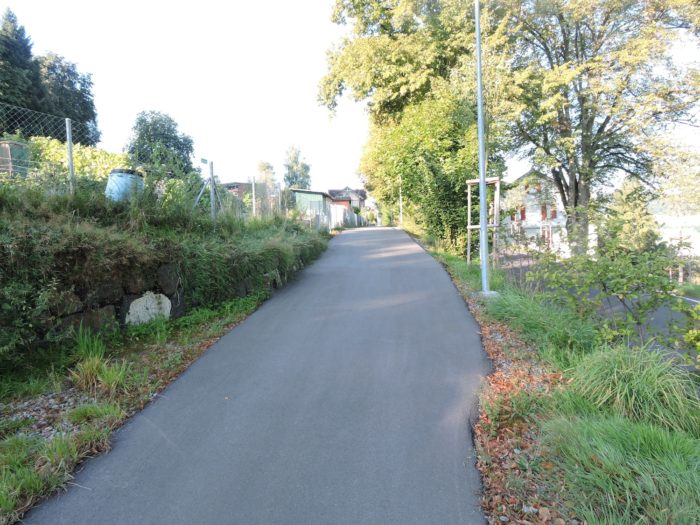 |
 |
The chapel, a symbol of piety and faith, recently erected, is nestled within the embrace of the Catholic parish. An immutable witness to the tumults of the 16th century, where Herisau, defying the protective shadow of the Abbey of Saint Gall, opted for Protestantism. Thus, the canton of Appenzell split into two distinct and autonomous entities: Inner Rhodes, the cradle of Catholic tradition, and Outer Rhodes, a bastion of the Reformed faith. Here, you tread on Protestant soil, where Herisau, like a celestial constellation, majestically emerges in its amphitheater of hills.
|
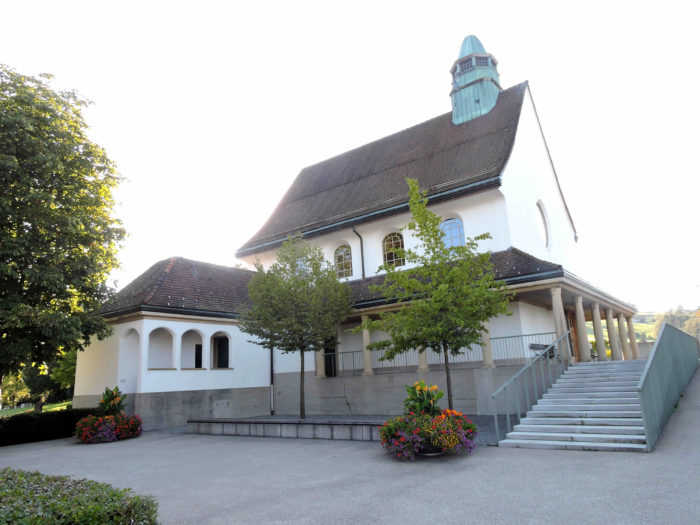 |
 |
| From this sacred promontory, the Via Jacobi begins its descent, meandering through Kreuzgasse to reach the pulsating heart of the city. |
 |
 |
| At the foot of this descent, a narrow-cobbled alley offers itself as a sesame, opening the doors to the historic center. The proud silhouette of the Saint-Laurent Reformed Church then rises on Dorfplatz, an immutable witness to centuries gone by. Of Romanesque origin, its current edifice stands as an exquisite example of late Gothic, transformed by the waves of the Reformation into sumptuous Rococo. |
 |
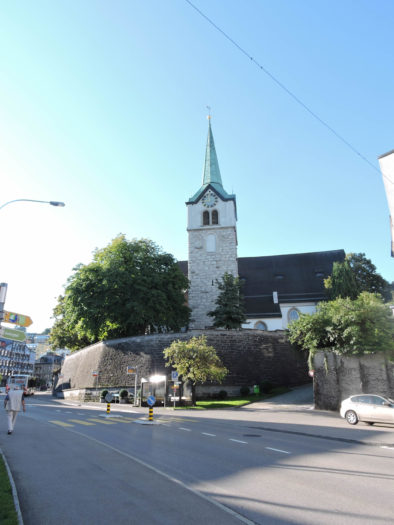 |
| Herisau (16,000 inhabitants), capital of the canton of Appenzell Outer Rhodes, stretches between the steep slopes of a hill and the tranquility of a valley embraced by the Glatt. From a modest rural hamlet, it has evolved over the centuries into a medium-sized city, where functionality and tradition harmoniously intertwine. Simply venture into the paved meanders of its alleys to catch glimpses of the remnants of a flourishing past: mural frescoes adorning facades, doors and windows painted in trompe-l’oeil style, majestic stone or wooden houses, silent witnesses of the golden age of the 17th century.
Within its midst, the town relishes in a symbiosis between modern buildings and ancient restored farms. Yet it is on Dorfplatz and in Schmiedgasse that architectural jewels are nestled, patrician mansions, heirs to the baroque splendor of the 18th century. Herisau remains, to this day, a sanctuary of lace, a living tribute to the ancestral craftsmanship that has shaped its identity. |
 |
 |
 |
 |
Accommodation on Via Jacobi
- Heberge am See, Churerstrasse 4, Rorschach; 071 844 97 12; Youth hostel
- Bodenseeblick, Wiesenhalde 4, Rohrschach; 071 850 95 50; Guestroom, breakfast
- Hôtel restaurant Enjoy, Kosterstasse 70, Rohrschach; 071 841 00 803; Hotel, dinner, breakfast
- Hôtel Mozart, Hafenzentrum, Rohrschach; 071 844 47 47; Hotel***, dinner, breakfast
- Hôtel Rebstock, Thalerstrasse 57, Rohrschach; 071 858 24 00; Hotel***, dinner, breakfast
- Jugendherberge St. Gallen, Jüchstrasse 25, St Gallen; 071 245 47 771; Youth hostel
- Pilgerherbege, Linsebühlstrasse, St Gallen; 071 220 00 62; Gîte pèlerin
- B&B Dianastrasse 4, St Gallen; 071 244 49 83/079 605 31 40; Guestroom, breakfast
- B&B Orion, Scheidwegstrasse 1, St Gallen; 076 375 26 63; Guestroom, breakfast
- Kräntzlinhotel, Augustinergasse 1, St Gallen; 076 524 26 16; Hotel, dinner, breakfast
- Schwanen Hotel /Restaurant, Webergasse 23, St Gallen; 071 222 65 62; Hotel, dinner, breakfast
- Restaurant Papagei, Hinterlauben 4, St Gallen; 071 222 24 66; Hotel, dinner, breakfast
- Hôtel Weisses Kreuz, Engelgasse 9, St Gallen; 071 223 28 43; Hotel, dinner, breakfast
- Hôtel am Spisertor, Moosbruggstrasse 1, St Gallen; 071 228 82 83; Hotel, dinner, breakfast
- Hôtel Vadian, Gallusstrasse 36, St Gallen; 071 228 18 78; Hotel**, breakfast
- Jägerhof, Brühlbleichestrasse 11, St Gallen; 071 245 50 22; Hotel***, dinner, breakfast
- Hôtel am Ring, Unterer Graben 9, St Gallen; 071 223 27 47; Hotel***, dinner, breakfast
- Sorell Hôtel City Weissenstein, Davidstrasse 22, St Gallen; 071 228 06 28; Hotel***, breakfast
- Radisson Blu Hôtel, St. Jakob-Strasse 55, St Gallen; 071 242 12 12; Hotel****, dinner, breakfast
- Einstein – Hôtel Congress Spa, Berneggstrasse 2, St Gallen; 071 227 55 55; Hotel****, dinner, breakfast
- B&B Bruggen, Lehnstrasse 28, Bruggen; 071 279 26 28/077 420 49 41; Guestroom, breakfast
- Hôtel Sporting, Straubenzellstrasse 19, Bruggen; 071 272 30 30; Hotel**, dinner, breakfast
- Theo & Nelly Steffen, Schwellbrunnerstrasse 19, Herisau; 071 352 61 27/077 454 35 60; Accueil jacquaire
- Openhouse Herisau, Degersheimerstrasse 22, Herisau; 077 450 32 60; Accueil jacquaire
- Monica Müller, Wyburgweg 2, Herisau; 071 352 61 27/077 454 35 60; Guestroom, breakfast
- Gasthaus Marktplatz, Zeughausstrasse 10, Herisau; 071 352 32 12; Guestroom, breakfast
- Arian Pizzeria Da Toni, Schmiedgasse 1, Herisau; 071 544 11 11 076 699 69 99; Guestroom, dinner, breakfast
- Hôtel Landhaus Säntis, Kasernenstrasse 29, Herisau; 071 353 01 00; Hotel, dinner, breakfast
- Gasthaus Oechsli, Schmiedgasse 3, Herisau; 071 351 23 26; Hotel, dinner, breakfast
- Hôtel Löwen, Poststrasse 3, Herisau; 071 351 17 55; Hotel, breakfast
- Hôtel Herisau, Bahnhofstrasse 14, Herisau; 071 354 83 83; Hotel***, dinner, breakfast
Finding accommodation on this stage is not very difficult. There are plenty of options, and all along the route, numerous restaurants and grocery stores are available. You will be in towns with all the necessary shops. It is easier to find accommodation on this variant of the via Jacobi 4 than on the one that passes through Lucerne and Bern. However, it is advisable to book in advance for more security.
Feel free to add comments. This is often how you move up the Google hierarchy, and how more pilgrims will have access to the site.
|
 |
Next stage : Stage 2: From Herisau to Wattwil |
|
 |
Back to menu |



































































